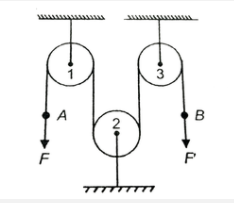Assertion:− Tension at every point in a massless rope is same.
Reason:− Tension in a rope is fundamentally electromagnetic in nature.
If both Assertion & Reason are True & the Reason is a correct explanation of the Assertion.
If both Assertion & Reason are True but Reason is not a correct explanation of the Assertiion.
If Assertion is True but the Reason is False.
If both Assertion & Reason are False
The correct Answer is:B
To solve the assertion and reason question, we need to analyze both the assertion and the reason provided.
1. Understanding the Assertion:
- The assertion states that "Tension at every point in a massless rope is the same."
- This is true because in a massless rope, there is no mass to create a difference in tension due to gravitational forces or any other forces acting on different segments of the rope. Therefore, the tension remains constant throughout the rope.
2. Understanding the Reason:
- The reason states that "Tension in a rope is fundamentally electromagnetic in nature."
- This statement is also true. Tension arises due to the intermolecular forces between the particles in the rope, which are indeed electromagnetic in nature. The forces that hold the molecules together in the rope are due to electromagnetic interactions.
3. Analyzing the Relationship:
- While both the assertion and the reason are true, we need to determine if the reason correctly explains the assertion.
- The assertion about the uniform tension in a massless rope is based on the absence of mass and the equilibrium of forces, while the reason discusses the nature of the forces causing tension.
4. Conclusion:
- The assertion is true, and the reason is also true, but the reason does not adequately explain why the tension is the same throughout a massless rope. The uniformity of tension is due to the rope being massless and the equilibrium of forces, not directly due to the electromagnetic nature of tension.
Final Answer:
- The assertion is true, and the reason is true, but the reason is not the correct explanation for the assertion.
- The assertion states that "Tension at every point in a massless rope is the same."
- This is true because in a massless rope, there is no mass to create a difference in tension due to gravitational forces or any other forces acting on different segments of the rope. Therefore, the tension remains constant throughout the rope.
- The reason states that "Tension in a rope is fundamentally electromagnetic in nature."
- This statement is also true. Tension arises due to the intermolecular forces between the particles in the rope, which are indeed electromagnetic in nature. The forces that hold the molecules together in the rope are due to electromagnetic interactions.
- While both the assertion and the reason are true, we need to determine if the reason correctly explains the assertion.
- The assertion about the uniform tension in a massless rope is based on the absence of mass and the equilibrium of forces, while the reason discusses the nature of the forces causing tension.
- The assertion is true, and the reason is also true, but the reason does not adequately explain why the tension is the same throughout a massless rope. The uniformity of tension is due to the rope being massless and the equilibrium of forces, not directly due to the electromagnetic nature of tension.
- The assertion is true, and the reason is true, but the reason is not the correct explanation for the assertion.
Topper's Solved these Questions
- TEST PAPERBOOK - ALLENCHAPTER - TEST PAPEREXERCISE - Exercise (Physics)
330 Videos
- TEST PAPERBOOK - ALLENCHAPTER - TEST PAPEREXERCISE - PHYSICS
4 Videos
- SIMPLE HARMONIC MOTIONBOOK - ALLENCHAPTER - SIMPLE HARMONIC MOTIONEXERCISE - Example
1 Videos
- TEST PAPER 1BOOK - ALLENCHAPTER - TEST PAPER 1EXERCISE - PHYSICS
11 Videos
Similar Questions
The tension at any point of the string AB will be same if

View SolutionThese questions consists of two statements each printed as Assertion and Reason. While answering these question you are required to choose any one of the following four responses
Assertion A string has a mass m. If it is accelerated, tension is non-uniform and if it is not accelerated, tension is uniform.
Reason Tension force is an electromagnetic force.
View Solution
Knowledge Check
Assertion : Electromagnetic waves are transverse in nature
Reason : The electric and magnetic fields in electromagnetic waves are perpendicular to each other and to the direction of propagation.AIf both assertion and reason are true and reason is the correct explanation of assertionBIf both assertion and reason are true but reason is not the correct explanation of assertionCIf assertion is true but reason is falseDIf both assertion and reason are falseAssertion : The electromagnetic wave is transverse in nature
Reason : Electromagnetic wave propagates parallel to the direction of electric and magnetic fields.AIf both assertion and reason are true and reason is the correct explanation of assertionBIf both assertion and reason are true but reason is not the correct explanation of assertionCIf assertion is true but reason is falseDIf both assertion and reason are falseAssertion : The basic laws of electromagnetism govern all electric and magnetic phenomena.
Reason : The attempts to unify fundamental forces of nature reflect the quest for unification.AIf both assertion and reason are true and reason is the correct explanation of assertion.BIf both assertion and reason are true but reason is not the correct explanation of assertion.CIf assertion is true but reason is false.DIf both assertion and reason are false.
Assertion :− Tension in massless string may be different at different points.
Reason :- Net force on a massless object may be zero
View Solution
Two persons pull each other through a massless rope in tugofwar game. Who will win?
View SolutionIn figure the tension in the rope (rope is light) is

View SolutionThe length , radius , tension and density of stringA are twice the same parameters of string B. Find the ratio of fundamental frequency of B to the fundamental frequency of A.
View SolutionA uniform rope of mass m hangs from a ceiling and a block of mass m is attached to the free end of rope.
Statement-1: The speed of a transverse wave in rope is different at different points.
Statement-2: The tension in the rope is different at diferent points.
View Solution
